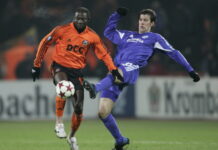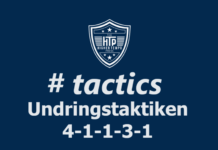In the evolution of our species, the role of pattern has been vital. Our survival would not have been possible without the ability to perceive patterns, and deviations from patterns, and the ability to produce them. That, for example, is how we make sense of our natural environment – from bush people in the Kalahari desert to scientists at NASA.
Pattern lies at the root of vast number of mental activities: knitting, decorating, writing poetry, cooking, doing mathematics, observing the sabbath…
…and playing FM.
As a manager, I find that patterning lies at the heart of my emotional engagement.
Here’s one example. The club that I’m currently managing has, after years of endeavour, developed a pattern. The expression of this is in the way they play. Players seem to understand what their roles are; they know where their colleagues are and what those colleagues can and can’t do.
This helps them to make good decisions. In any situation, some decisions will be out of bounds (defenders don’t play risky passes here). That means they have fewer options to worry about. Yet it can also permit some creativity: they can join the dots in different ways.
I do sometimes hear people talk about pattern in football (‘there’s a real pattern to their play’). Not that often, though. People more often talk about style or tactics. (‘Style’ itself usually means, to large degree, tactics: we talk, for example, of the ‘long ball game’ as a style.)
But when I talk of ‘pattern’ I’m don’t mean either simply ‘style’ or ‘tactics’. Though the three terms overlap, they’re not synonyms.
I can explain the difference this way. When people write blog posts about tactics, they tend to provide two types of screen dump — one showing a formation and the other showing team instructions.
With a pattern you couldn’t really do that. The more the pattern develops, the more the team instructions might vary. Sometimes counter; sometimes control, for example; or sometimes lower tempo and sometimes normal. Roles too might change — and, arguably, formations too. You might, for example, drop one of your strikers back to a shadow striker to exploit a gap in your opponent’s expected formation.
A pattern, therefore, is broader and more flexible than a tactic. It’s better thought of as a loose arrangement that brings together a family of tactics and a range of instructions.
It also seems to me that the more intuitive the pattern becomes to the players, the more you can dispense with instructions.
What has this to do with emotional engagement?
Two things. First, when a squad starts to play to a pattern, it’s immensely satisfying on an aesthetic level.
Second, it takes a long time to develop a pattern. I certainly think that, at least in the non-elite leagues I manage in, we’re talking seasons, plural. Quite possibly several. The pattern evolves as a product of player acquisitions, preferred moves, style of training, squad stability, and so on – and, especially, plenty of playing time out on the pitch.
It is, therefore, something you have to develop. In fact, it’s something you co-create, with your players and staff. And so it is something you have a stake in.
Pattern, therefore, means there’s a little bit of you out on the pitch – and the more it allows you to devolve decisions to your players, the more you can take pride in the achievement.

























